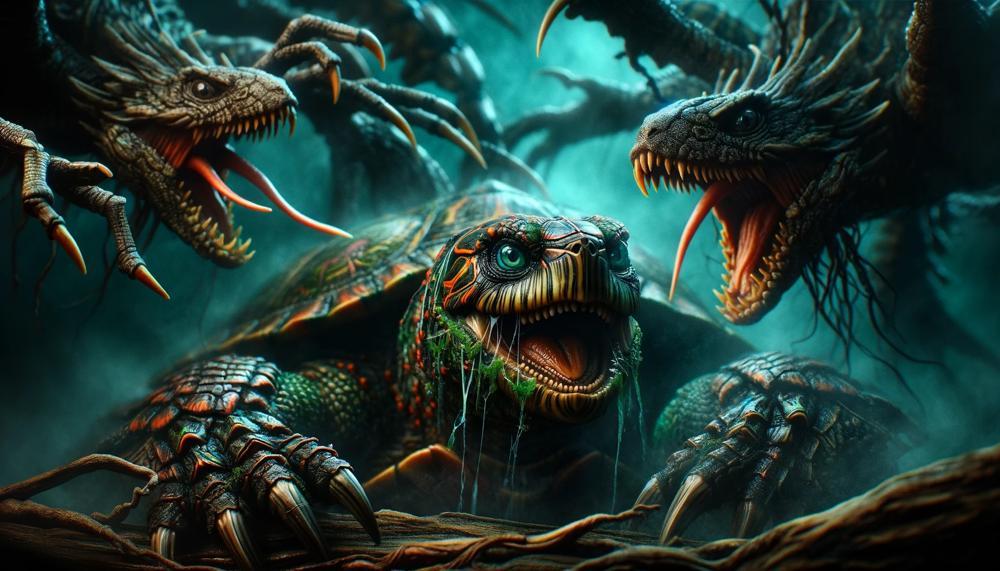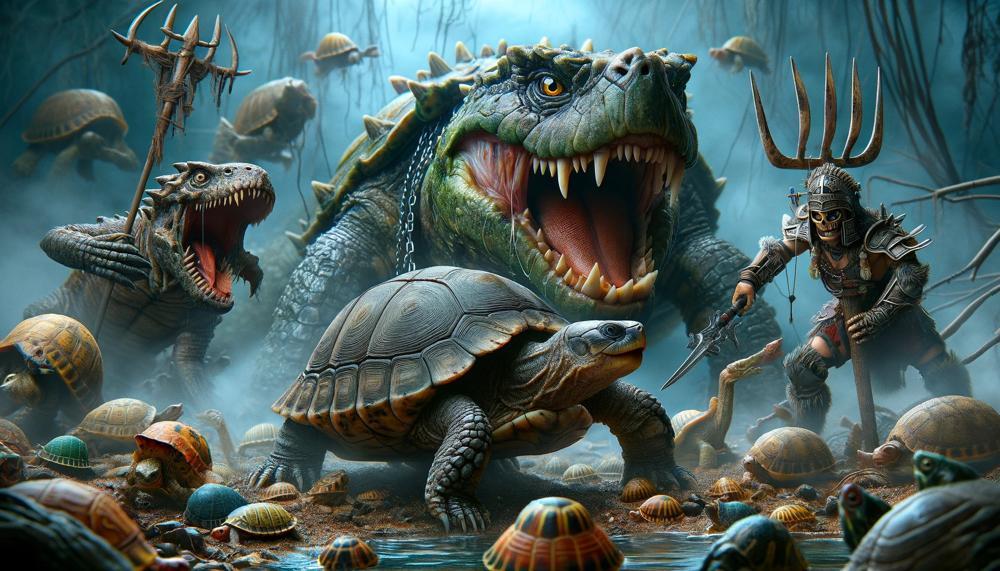Turtles, those ancient mariners and land dwellers that carry their homes on their backs, navigate a world filled with beauty and danger.
While their shells provide a formidable defense against many threats, turtles are not without their predators.
This blog post embarks on an exploratory journey into the intricate web of survival, uncovering the myriad of predators that pose a threat to turtles at different stages of their lives. From the moment of hatching, when they’re most vulnerable, to their adult lives in water and on land, turtles face a constant battle for survival.
Our exploration will take you beneath the waves and across continents, shedding light on the natural adversaries of these fascinating creatures.
Key Takeaways:
- Predator Variety: Turtles face predators from multiple realms, including aquatic, terrestrial, and aerial threats.
- Life Stage Vulnerability: The risk of predation varies significantly with the turtle’s life stage, with hatchlings facing the greatest danger.
- Adaptations and Defenses: Despite their vulnerabilities, turtles have evolved remarkable adaptations to evade and survive predator attacks.
- Conservation Implications: Understanding turtle predators is crucial for conservation efforts, highlighting the importance of protecting habitats and managing predator populations.
As we delve deeper into the dynamics of turtle predation, we’ll uncover the challenges these ancient creatures face and the resilience they exhibit in the face of adversity.
Join us on this fascinating journey to better understand the natural world’s interconnectedness and the pivotal role turtles play within it.
Contents
List of Turtle Predators:
Turtles, both terrestrial and marine, have a variety of predators that vary across their lifecycle stages from hatchlings to adults.
These predators significantly impact turtle populations by influencing their survival rates and contributing to the natural selection process.
Understanding these predatory relationships is crucial for conservation efforts and ecosystem management.
Predators of Hatchlings and Juveniles:
- Birds: Seagulls, crows, and frigatebirds are known to prey on hatchlings as they make their perilous journey from the nest to the sea. This predation is a critical natural challenge that only the swiftest and most fortunate overcome.
- Crabs: Coastal crabs, especially the larger species, pose a significant threat to both eggs laid in nests and emerging hatchlings, reducing the number of young turtles that reach the ocean.
Predators of Adult Turtles:
- Sharks: Tiger sharks and great white sharks are formidable predators of adult sea turtles, capable of overpowering even the strongest adult turtles in the open ocean.
- Killer Whales and Saltwater Crocodiles: These apex predators can occasionally prey on adult turtles, showcasing the vulnerability of turtles even at maturity.
Human Impact:
- Although not natural predators, humans significantly impact turtle populations through habitat destruction, pollution, and bycatch in fishing gear, highlighting the need for concerted conservation efforts.
Ecosystem Role:
Predators play an essential role in maintaining the health and balance of marine ecosystems by controlling turtle populations and preventing overpopulation, which can lead to imbalances in marine environments.
Conservation Considerations:
Efforts to protect turtle habitats and implement safer fishing practices are vital to mitigate the impact of human activities on turtle populations, ensuring their survival and the stability of marine ecosystems.
What are the Most Vulnerable Turtles
The vulnerability of turtles to predators hinges on a melange of factors such as size, habitat, shell type, coloration, and behaviour.
Each turtle species weaves its own tapestry of survival strategies, yet some find themselves more susceptible to the threats lurking in their environs.
Size Matters
Larger turtles often intimidate would-be predators with their sheer bulk and robust shells. These natural fortresses deter many attempts on their lives, marking a stark contrast to their smaller kin, who find themselves more frequently targeted due to their less formidable defenses.
Habitat: A Double-Edged Sword
Aquatic turtles glide through the water, often eluding predators with their adept swimming. The vastness of their aquatic realm provides numerous hideaways.
Conversely, their terrestrial cousins are more exposed, with fewer places to conceal themselves, making them easy pickings for predators.
The Shell Tells a Story
| Type | Vulnerability | Reason |
| Softshell | High | Softer, more penetrable shells. |
| Hardshell | Low | Harder, more impenetrable defenses. |
Softshell turtles’ more pliable armor leaves them at a disadvantage, offering less resistance against the bites of determined foes. Hardshell counterparts, however, boast sturdy carapaces that stand as bulwarks against attacks.
Coloration: A Blend or a Beacon?
Turtles sporting dull, earthy tones meld into their surroundings, whispering tales of camouflage and survival.
This natural invisibility cloak serves them well, a stark contrast to their brightly colored brethren, whose vivid shells act as beacons to predators.
Behaviour: The Nighttime Gambit
Nocturnal turtles gamble with darkness, using the veil of night as cover. Their diurnal counterparts, basking under the sun, are not so fortunate, with daylight revealing their locations to hungry eyes.
How Turtles Defend Themselves
Turtles, those ancient mariners and land wanderers, have crafted a suite of formidable defenses through the eons to shield themselves from the jaws and claws of predators.
Below is a distilled essence of their survival tactics, as observed in their natural habitats and battles for existence.
| Defense Mechanism | Description | Notable Species |
| Hard External Shell | A fortress of keratin and bone, the turtle’s shell is its primary defence, offering a near-impenetrable barrier against many predators. | All species |
| Streamlined Bodies | Especially in sea turtles, streamlined bodies facilitate swift swimming, dodging predators with graceful agility in their blue aquatic realm. | Sea turtles (e.g., Green, Loggerhead) |
| Claws and Strong Jaws | Equipped with claws for grappling and sharp jaws for biting, turtles can fend off attackers or dissuade them from considering the turtle as prey. | Snapping turtles |
| Large Upper Eyelids | These act as shields, protecting the eyes from debris and potential threats, aiding in their survival in both terrestrial and aquatic environments. | Sea turtles |
| Hatchling Strategies | Hatchlings head towards the brightest horizon and emerge in groups to overwhelm predators by their sheer numbers, a tactic known as “predator swamping”. | Sea turtles |
| Breath Holding | Capability to hold their breath for extended periods allows them to stay submerged and out of reach from many threats. | Sea turtles |
These defenses, evolved over millions of years, demonstrate turtles’ remarkable adaptability and resilience. Yet, despite their armory, they remain vulnerable to human threats such as illegal fishing and habitat destruction.

It’s our duty to ensure these ancient navigators of land and sea persist, embodying the marvels of natural selection and adaptation.
What are We Doing to Help turtles
We are employing a range of strategies to shield turtles from their natural predators and those that have emerged due to our activities. These efforts are essential for the conservation of these venerable creatures who’ve roamed our oceans and lands for aeons.
Below, find a table detailing key methods employed to keep these shelled survivors safe.
| Protection Method | Description | Impact |
| Nesting Beach Patrolling | Volunteers and conservationists monitor beaches during nesting and hatching seasons, keeping watch over nests and guiding hatchlings to the sea. | Reduces the risk from predators like birds and crabs, and human interference. |
| Exclusion Devices | Installation of barriers or fences around nesting sites to prevent access by predators such as dogs, foxes, and raccoons. | Enhances hatchling survival rates by minimizing predation at vulnerable nesting sites. |
| Artificial Lighting Regulation | Enforcing guidelines on lighting near beaches to prevent disorienting hatchlings, leading them away from the sea where they’re more vulnerable to predators. | Ensures more hatchlings reach the sea, reducing the window of exposure to predators. |
| Educating Communities | Providing knowledge to local communities and tourists about the importance of turtles and how to interact responsibly with their habitats. | Reduces human-induced threats and disturbances, indirectly mitigating the risk from human-facilitated predators. |
| Rescue and Rehabilitation | Facilities dedicated to the care of injured or sick turtles, offering them a second chance at life in the wild. | Increases the population of healthy turtles, bolstering their numbers against predation pressures. |
These measures, coupled with global conservation laws and treaties, offer a beacon of hope for these ancient mariners.
It’s a collective endeavour, requiring the commitment of not just conservationists but every beachgoer, fisherman, and coastal resident to make a difference.
Before You Leave
Before You Leave a turtle in the wild to ensure its safety from predators, it’s pivotal to take a methodical approach that not only secures the turtle’s immediate safety but also bolsters its chance of survival in its natural habitat.
The essence of this task lies in meticulous preparation and an understanding of the creature’s needs and environmental demands.
| Step | Action | Purpose |
| Health Assessment | Consult with a veterinarian or a wildlife expert. | Ensures the turtle is healthy and capable of survival in the wild. |
| Habitat Selection | Choose a release site that matches the turtle’s natural environment. | Reduces stress and enhances adaptability to the wild. |
| Acclimatization | Gradually introduce the turtle to its new surroundings. | Helps the turtle adjust to the wild, reducing the risk of shock. |
| Predator Awareness | Release during a time of day when predators are less active. | Minimises immediate threats from predators, giving the turtle a better chance to acclimatise. |
| Soft Release | Monitor the turtle from a distance initially after release. | Ensures the turtle is adapting well and can find food and shelter. |
| Community Education | Inform local communities about turtles and their conservation. | Creates allies in the local population, fostering a safer environment for the turtle. |
| Ongoing Support | Stay in touch with wildlife experts for advice and intervention if needed. | Provides a safety net for the turtle, ensuring help is available if it struggles in the wild. |
Taking these steps seriously not only sets the stage for a successful transition back to the wild for the turtle but also contributes to the broader goal of conservation.
It’s about giving these majestic creatures a fighting chance while respecting the delicate balance of our ecosystems.
Conclusion
Turtles develop as ancient sailors and terrestrial wanderers in the delicate dance of nature, navigating a world full of beauty and danger. Our exploration of the world of turtle predation presents a striking picture of the difficulties these hardy animals encounter from the time of hatching until adulthood.
Turtles face a wide range of predators, from the sky above to the lands they travel and the depths of the waters they live in, despite their strong shells. Turtles live under constant assault from a variety of predators, including birds, crabs, sharks, and even the threatening presence of saltwater crocodiles and killer whales.
But in the face of hardship, turtles show incredible tenacity and flexibility, developing a variety of defenses that are a testament to the inventiveness of nature. Turtles are the perfect example of the art of survival despite overwhelming odds because of their robust exterior armor, clever use of camouflage, and cooperative hatching tactics. But the long shadow of human activity complicates their survival story via habitat degradation, pollution, and bycatch, making conservation efforts even more crucial.
Our research confirms an important finding: knowledge about turtle predators sheds light on the larger story of ecological interdependence and the pressing need for human stewardship. It’s a cry to action, asking us to protect these extinct animals and the complex ecosystem they live in.






